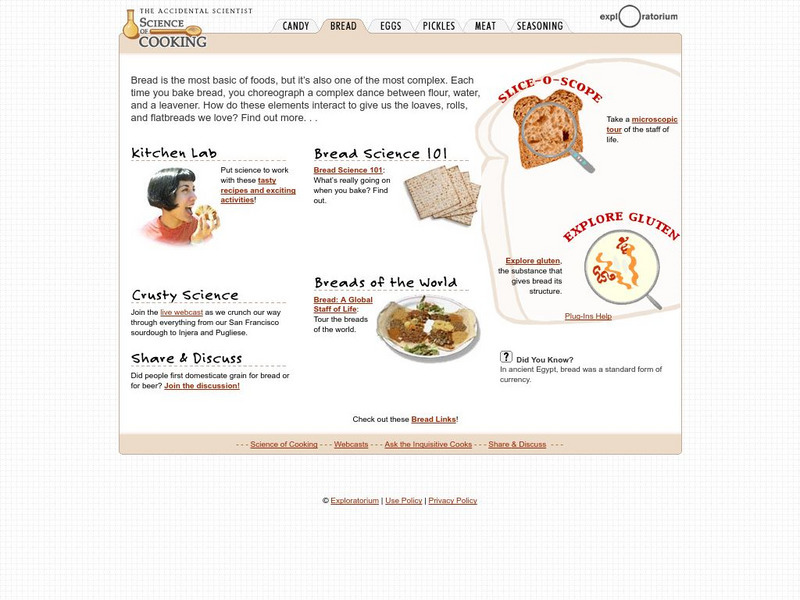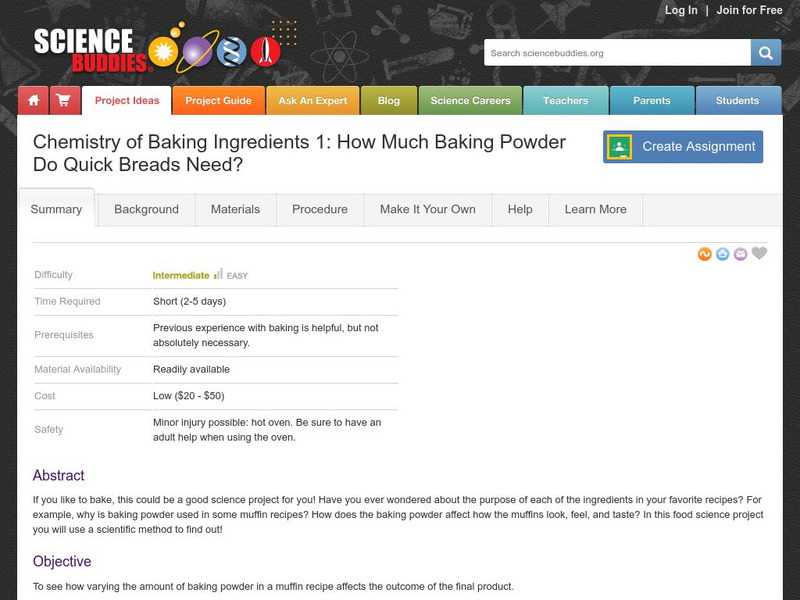Hi, what do you want to do?
Curated OER
TE Activity: Yeast Cells Respire, Too (But Not Like Me and You)
Student observe and quantify the respiration that occurs in yeast-molasses cultures. They complete an effective experiment in order to examine how to think critically about the results.
Curated OER
Yeast and Respiration
Students explore oxygen properties by conducting a cell experiment in class. In this respiration lesson, students discuss the process of breathing and how oxygen is inhaled before carbon dioxide is exhaled. Students utilize yeast, water,...
Curated OER
Galaxy Mapping
Students research the constellations and discuss their findings. Then they construct their own maps of the galaxy using paper, black paint, aluminum foil, etc. They make a 3-D map of their chosen constellation.
Curated OER
Physical And Chemical Changes
Second graders identify physical and chemical changes of matter. They distinguish between physical and chemical changes. They classify changes as physical or chemical.
Curated OER
Activity #6 How Fast Do Reactions Go?
Students name the factors (concentration, temperature, and a catalyst) which can affect the rate of a chemical reaction. They use their knowledge of particle theory to explain their observations. Pupils comprehend that the...
Curated OER
Chemical Leavening Agents
Students examine chemical leavening agents in dough and batters.
Curated OER
St. Patrick's Day Snack
First graders design a green snack menu from all four food groups for St. Patrick's Day.
Curated OER
Chemical Changes
Second graders investigate chemical changes and reactions and will identify four characteristics that indicate a chemical change. In this chemical change lesson plan, 2nd graders perform experiments that promote chemical changes. They...
Curated OER
Kitchen Chemistry
Fifth graders examine both physical and chemical changes, and how to identify the difference between the two. They observe the changes that occur in butter when it is exposed to heat and cold, heat energy. In their notebooks, they write...
Curated OER
Agriculture in Motion
Youngsters learn about simple machines that could be used on a farm. They learn about agricluture, listen to a farmer speak, compare and contrast different farm machines, and then design their own. Note that although the publisher...
Curated OER
Agriculture in Motion
Sixth graders write a poem and an essay about the machines they have learned about that are used in agriculture. In this machines lesson plan, 6th graders compare different kinds of machines and discuss the economic impact machines in...
Curated OER
Agriculture in Motion
Students discuss agriculture. In this farming lesson, students compare farming practices from the past compared to when machines were introduced. They discuss this concept as a class and participate in multiple activities. This lesson...
Curated OER
Dancing Rainbows: A Pueblo Boy's Story
Students read the book "Dancing Rainbows," and complete a variety of activities across the curriculum. For this Native Americans lesson plan, students create pottery, discuss Pueblo traditions, discuss the importance of rain, and learn...
Curated OER
Cellular Respiration
In this cellular respiration worksheet, students compare the following processes: cellular respiration, glycolysis, lactic acid fermentation, and alcoholic fermentation. This worksheet has 9 short answer, 6 matching, 3 multiple choice,...
Curated OER
Growing Gold
Students read and explore a folktale from India. In this folktale lesson, students read the book Growing Gold and discuss the events from the tale. Students complete a phonics worksheet which incorporates the rhyming words from the text.
Curated OER
Represent Fractions
Using word problems can be a good way to help students practice working with fractions. In this worksheet on fractions, students solve problems involving real-life examples. This worksheet is part of the Houghton Mifflin math series and...
Exploratorium
Exploratorium: Bread Science
From Chinese baozi to Armenian lavash, bread comes in thousands of forms. Find out, on the most basic level, what chemistry ties them all together.
Exploratorium
Exploratorium: Science of Cooking: Bread Science and Facts
Find out the science behind making bread. This site from Exploratorium turns your kitchen into a lab and you can do much more than bake bread. Do experiments with yeast, and find out what is so exciting about gluten.
Science Buddies
Science Buddies: How Much Baking Powder Do Quick Breads Need?
If you like to bake, this could be a good project for you. There is a purpose for each of the ingredients in your recipes, but not everyone is always aware of what that purpose may be. Though this lab takes multiple days, you will...
Other
The Happy Scientist: Bread Bubbles
This experiment is about bread. If you have used my website for long, you know that I like experiments with food, especially when it is tasty food. We regularly bake bread, and there are few smells that are better than the smell of...
Science Buddies
Science Buddies: Yeast Reproduction in Sugar Substitutes
There's nothing quite like the smell of fresh-baked bread to make your mouth water. As any baker can tell you, you can't bake bread without yeast. This project makes clever use of bread dough to measure yeast reproduction three different...
American Chemical Society
American Chemical Society: Development of Baking Powder
The invention of baking powder had a huge impact on bakers' ability to produce and distribute bread to large numbers of people. The history of this lowly ingredient is presented, along with a chemistry lesson plan for secondary students.


























